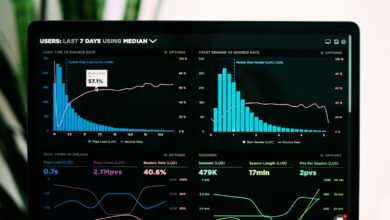Robo-advisors – automated investment management

Leverage algorithm-driven platforms to optimize portfolio allocation with minimal human intervention. These systems utilize cutting-edge technology to perform continuous rebalancing, ensuring alignment with target risk profiles and market conditions. Low operational costs translate into more capital deployed toward asset growth rather than fees, making this approach highly efficient for both novice and experienced investors.
By integrating sophisticated algorithms, these services analyze real-time financial data to adjust holdings dynamically, reducing behavioral biases commonly associated with manual decision-making. The cost advantage stems from automation that eliminates many traditional overheads, allowing access to diversified strategies previously reserved for high-net-worth individuals. This model supports scalable solutions while maintaining rigorous adherence to investment objectives.
Strategic rebalancing executed by these platforms preserves intended asset mixes despite market fluctuations, enhancing long-term returns through disciplined portfolio discipline. Embracing this technology enables precise execution of complex allocation methods at a fraction of the usual expense. Investors benefit from transparent fee structures and streamlined processes that prioritize capital efficiency without sacrificing customization or control.
Robo-advisors: automated investment management [Investment Insights investment-insights]
Utilizing algorithm-driven platforms for portfolio oversight significantly reduces operational expenditures while maintaining strategic asset allocation. These systems employ sophisticated technology to monitor market conditions and execute timely adjustments, enabling precise rebalancing aligned with predefined risk profiles. Data from multiple providers indicate average annual fees between 0.20% and 0.50%, substantially lower compared to traditional advisory services.
The integration of machine learning models enhances decision-making processes by dynamically adapting to evolving market volatility without human bias. Such software solutions support diversified asset classes, including equities, bonds, and increasingly, digital assets, offering a broad spectrum of exposure tailored to individual financial objectives.
Technological Foundations and Cost Efficiency
Core frameworks underpinning these platforms rely on APIs connected to real-time data feeds, ensuring continuous portfolio evaluation against benchmarks. The automation of routine tasks such as contributions processing and tax-loss harvesting contributes to minimizing manual intervention costs. For example, Betterment’s platform reported over $22 billion in assets under supervision with consistent cost advantages stemming from its algorithmic approach.
Clients benefit from a transparent fee structure coupled with scalable service levels; entry thresholds often start at minimal amounts, democratizing access for smaller capital holders. Comparative studies highlight that the savings accrued via reduced commissions and overheads can compound into significant net gains over extended horizons.
Rebalancing Mechanisms and Risk Calibration
Periodic reallocation algorithms maintain alignment with target asset mixes by assessing deviations exceeding preset tolerance bands. This systematic adjustment mitigates drift caused by fluctuating market returns and preserves intended risk-return characteristics. Case analysis of Wealthfront’s daily rebalancing model demonstrates enhanced portfolio stability during volatile phases through incremental trades rather than wholesale shifts.
- Tolerance thresholds: Typically set between 5%–10% deviation triggers
- Frequency: Ranges from daily checks to quarterly reviews depending on platform sophistication
- Execution: Automated orders executed via brokerage integration reduce latency and slippage
Diverse Asset Integration Including Digital Currencies
The evolution of these advisory engines includes support for crypto-assets alongside conventional securities, reflecting growing investor interest in blockchain-based holdings. Platforms like Titan Crypto incorporate proprietary risk models assessing factors such as liquidity constraints and regulatory developments unique to cryptocurrencies. This diversification enables clients to access non-correlated assets within a single cohesive framework.
Regulatory Environment Impacting Platform Operations
The compliance landscape mandates transparency in algorithm functionality and client disclosures regarding risks inherent in automated strategies. Recent SEC guidelines emphasize the necessity for periodic audits of model accuracy and cybersecurity measures safeguarding user data integrity. Adhering entities implement robust governance frameworks ensuring ethical use of artificial intelligence in portfolio construction.
This regulatory scrutiny fosters increased trust among investors while compelling continuous technological improvements that enhance reliability and responsiveness under varying economic conditions.
Future Perspectives on Algorithmic Portfolio Oversight
The trajectory points toward deeper customization capabilities driven by advancements in artificial intelligence interpreting behavioral finance indicators alongside macroeconomic trends. Enhanced predictive analytics will facilitate preemptive strategy shifts mitigating downside exposures before adverse movements materialize.
An emerging paradigm involves hybrid models combining human expertise with computational precision, optimizing outcomes through collaborative oversight rather than sole reliance on autonomous systems. Investors should evaluate platform transparency, historical performance data, and adaptability features when selecting solutions aligned with their long-term goals.
Choosing Robo-advisors Platforms
Selecting a platform for automated portfolio oversight demands prioritizing cost efficiency, as fees can significantly impact net returns over time. Platforms with annual expense ratios below 0.25% provide competitive pricing, especially when combined with minimal or no minimum balance requirements. Evaluating fee structures alongside potential hidden charges, such as withdrawal or inactivity fees, ensures clarity on total expenses.
Rebalancing frequency and methodology represent critical technical features. Many platforms employ algorithm-driven triggers to maintain target asset allocations within predefined thresholds, often conducting reviews quarterly or upon market volatility events. Continuous rebalancing algorithms optimize portfolio drift correction while minimizing tax implications in taxable accounts through strategic asset swaps and tax-loss harvesting.
Key Technical Aspects for Platform Selection
The core of such solutions lies in their proprietary algorithms, which analyze risk tolerance, time horizon, and financial goals to generate customized asset mixes. Advanced machine learning models enhance predictive accuracy by integrating macroeconomic indicators and real-time market sentiment data. Comparing the sophistication of these algorithms helps identify providers capable of adapting dynamically to evolving market conditions without manual intervention.
Technology infrastructure supporting these services must guarantee security and uptime reliability. Cloud-native architectures enable scalability and rapid deployment of updates, while end-to-end encryption protects sensitive client information. Additionally, platforms that offer API access facilitate integration with third-party tools for enhanced reporting and analytics capabilities preferred by institutional investors.
- Low entry barriers: Some platforms accept initial deposits as low as $100, democratizing access to diversified portfolios.
- Diversification breadth: Inclusion of alternative assets like cryptocurrencies or ESG-focused funds expands opportunity sets beyond traditional equities and bonds.
- User interface: Intuitive dashboards presenting real-time metrics empower investors to track performance transparently.
A comparative case study involving two leading platforms revealed divergent strategies: one prioritized ultra-low fees coupled with quarterly rebalancing using mean-variance optimization models; the other leveraged AI-enhanced tactical allocation with weekly adjustments but at higher costs. The former demonstrated superior long-term cost-efficiency while the latter showed responsiveness during volatile periods, highlighting trade-offs between price sensitivity and active adaptation.
Regulatory frameworks also influence platform selection criteria. Compliance with regional standards such as MiFID II in Europe or SEC regulations in the US enforces stringent transparency about algorithmic decision rules and conflict-of-interest disclosures. Adherence ensures investor protection against opaque practices common in less regulated environments. Future-proof platforms anticipate tightening guidelines by incorporating explainability modules that clarify algorithmic outputs to end-users.
Setting Risk Preferences
Determining risk tolerance is a fundamental step in configuring portfolio algorithms for tailored capital allocation. Quantitative models within advisory platforms evaluate client questionnaires and behavioral data to assign risk scores, which guide asset distribution across equity, fixed income, and alternative instruments. These scores directly influence dynamic adjustment mechanisms that maintain alignment with predefined volatility thresholds, ensuring exposure remains within acceptable bounds while pursuing target returns.
Algorithmic frameworks incorporate factors such as time horizon, liquidity requirements, and market volatility to fine-tune sensitivity to downside risks. For instance, portfolios designated as low-risk typically emphasize high-grade bonds and cash equivalents with minimal drawdown potential. Conversely, aggressive profiles allocate significant weight to growth-oriented assets like emerging market equities or sector-specific ETFs, accepting higher fluctuations in exchange for enhanced appreciation prospects. This stratification enables systematic differentiation of investment strategies by risk appetite.
Integration of Rebalancing Protocols
Periodic rebalancing algorithms act as corrective processes that restore initial asset proportions disrupted by price movements or contribution changes. By automating these adjustments at predetermined intervals or threshold deviations, the system curtails unintended drift from established risk parameters. Empirical studies demonstrate that disciplined reallocation improves risk-adjusted returns by preventing disproportionate concentration in overperforming sectors while capturing gains through controlled divestment.
Advanced technological solutions leverage machine learning techniques to optimize rebalancing frequency based on transaction costs and tax implications alongside market conditions. Case analyses reveal that adaptive schedules outperform rigid monthly cycles by reducing unnecessary trades during low-volatility phases and intensifying oversight amid turbulent periods. Such precision enhances the effectiveness of portfolio governance aligned with investor comfort levels regarding variability and loss tolerance.
Cost Structures Explained
To optimize portfolio performance, it is essential to understand the cost dynamics embedded within algorithm-driven financial platforms. These systems leverage cutting-edge technology to perform continuous rebalancing, which aims to maintain target asset allocations with minimal friction. The operational expenses involved typically include platform fees, transaction costs, and underlying fund charges. Notably, the application of sophisticated algorithms allows for low-cost maintenance by automating routine adjustments and reducing human intervention.
Fee models often follow a percentage-based structure relative to assets under supervision, frequently ranging between 0.15% and 0.50% annually. This contrasts favorably with traditional advisory services where fees may exceed 1%. The reduced cost base stems from scalable infrastructure and streamlined workflows inherent in these software-driven solutions. Furthermore, low minimum investment thresholds expand access to diversified portfolios without disproportionate expense burdens.
Breakdown of Expense Components
Transaction costs incurred during periodic realignment of portfolios represent a significant element influencing net returns. Advanced algorithms minimize turnover by timing trades efficiently and aggregating orders across client accounts, thereby lowering brokerage commissions and bid-ask spreads. Additionally, tax optimization features incorporated in some platforms further reduce drag on capital through strategic selling strategies.
Underlying product fees constitute another major factor affecting total cost exposure. Many platforms utilize exchange-traded funds (ETFs) or index funds characterized by inherently low expense ratios–often under 0.10%. This selection process is governed by proprietary scoring systems that balance cost-efficiency against liquidity and tracking error metrics, ensuring portfolio integrity while maintaining competitive pricing.
The technological backbone supporting these services employs machine learning models that continuously analyze market conditions to adjust risk parameters dynamically. This automation not only lowers administrative overhead but also enhances precision in maintaining desired asset mixes despite volatile price movements. Consequently, clients benefit from consistent adherence to strategic allocation targets without incurring excessive operational costs.
Comparative case studies reveal that platforms emphasizing algorithmic sophistication achieve lower effective expense ratios than those relying heavily on manual portfolio oversight. For instance, a study examining cost efficiency across various providers demonstrated that fully automated systems reduced annualized costs by up to 40% compared to hybrid models combining automated tools with human advisors. Such data underlines the growing importance of technology-led solutions in delivering affordable wealth growth mechanisms.
Conclusion
Optimal tax efficiency hinges on leveraging low-cost portfolio adjustments driven by sophisticated algorithms that handle periodic asset rebalancing. The integration of smart advisory platforms enables precise alignment with tax-loss harvesting opportunities, minimizing liabilities without sacrificing portfolio integrity.
Future advancements will deepen the synergy between predictive analytics and regulatory compliance, allowing for more granular control over capital gains realization and deferred tax events. As these systems refine their decision-making through machine learning, users can expect increasingly tailored strategies that dynamically adapt to shifting fiscal environments while preserving cost-effectiveness.
Key Technical Insights
- Algorithmic rebalancing: Automated triggers ensure portfolios maintain target risk profiles while optimizing for after-tax returns by selectively realizing losses.
- Cost minimization: Efficient transaction execution and reduced human intervention substantially lower operational expenses compared to traditional methods.
- Dynamic tax-loss harvesting: Continuous monitoring identifies optimal timing to offset gains with losses, enhancing net performance over market cycles.
- Regulatory adaptability: Future-proof designs incorporate evolving tax codes, facilitating compliance without manual recalibration.
The broader impact on wealth accumulation lies in transforming passive allocation into an active fiscal strategy embedded within portfolio oversight. This evolution prompts reconsideration of how capital is preserved and grown under complex taxation regimes, especially as digital assets gain prominence. Professionals should anticipate a shift toward multi-asset frameworks where algorithm-driven tools extend beyond equities into cryptocurrencies and tokenized securities, further expanding avenues for tax optimization at minimal overhead.






